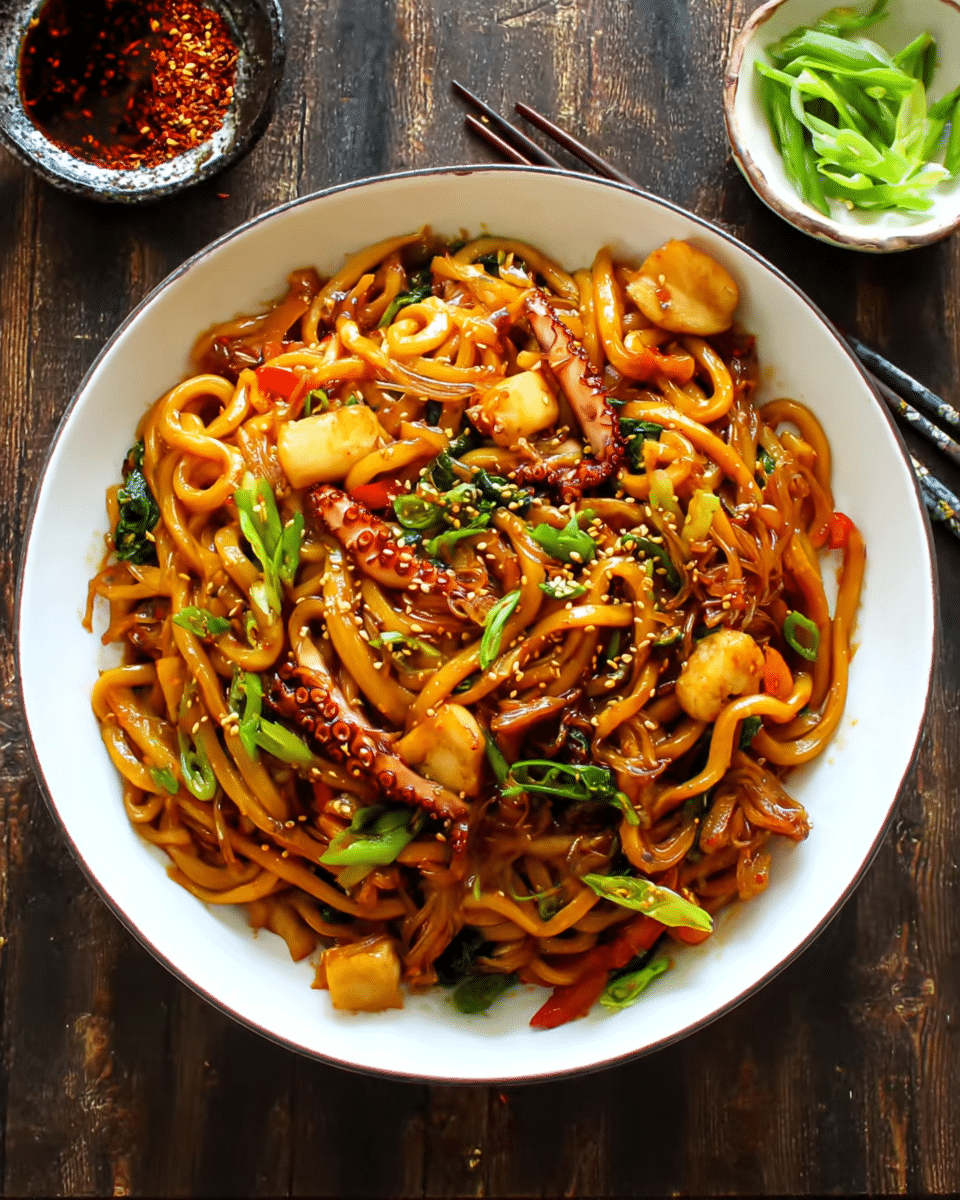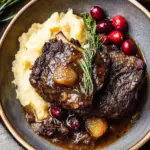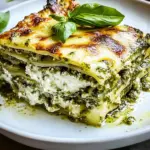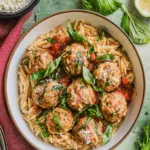These Thai Coconut Curry Shrimp Noodle Bowls are a perfect combination of creamy coconut milk, aromatic red curry, and succulent shrimp. The dish is balanced with fresh vegetables and a light, flavorful broth, making it incredibly comforting.
The bright colors of the red bell peppers and fresh cilantro add an appealing contrast to the rich curry sauce. It’s an easy yet delicious dish that will impress any guest, and the best part is, it’s perfect for a quick weeknight dinner or a special weekend meal. The heat from the curry paired with the creaminess of the coconut milk offers a delightful harmony of flavors, while the rice noodles soak up all the goodness.
Full recipe:
Ingredients:
-
1 lb shrimp, peeled and deveined
-
2 tablespoons olive oil
-
1 tablespoon fresh ginger, grated
-
2 cloves garlic, minced
-
1 can (14 oz) coconut milk
-
1 tablespoon red curry paste
-
1 tablespoon soy sauce
-
1 teaspoon fish sauce
-
1 teaspoon brown sugar
-
8 oz rice noodles
-
1 red bell pepper, thinly sliced
-
1/2 cup chopped cilantro
-
1 tablespoon lime juice
-
Salt and pepper to taste
-
Sriracha sauce, for garnish (optional)
Directions:
-
Heat olive oil in a large skillet over medium-high heat. Add the shrimp and cook until pink, about 2-3 minutes per side. Remove the shrimp from the skillet and set aside.
-
In the same skillet, add the ginger and garlic. Sauté for 1-2 minutes until fragrant.
-
Stir in the coconut milk, red curry paste, soy sauce, fish sauce, and brown sugar. Bring the mixture to a simmer and cook for 5-7 minutes to allow the flavors to meld.
-
Meanwhile, cook the rice noodles according to the package instructions. Drain and set aside.
-
Add the cooked shrimp and sliced bell pepper to the skillet, stirring to coat in the sauce. Simmer for an additional 3-4 minutes until the bell pepper is tender.
-
Toss the cooked noodles with the coconut curry shrimp mixture, then stir in chopped cilantro and lime juice. Season with salt and pepper to taste.
-
Serve immediately, garnished with sriracha sauce and extra cilantro if desired.
Prep Time: 15 minutes | Cooking Time: 15 minutes | Total Time: 30 minutes | Kcal: 425 kcal | Servings: 4 servings
The Flavors of Thai Coconut Curry
The Thai Coconut Curry Shrimp Noodle Bowls draw their inspiration from classic Thai dishes that showcase the unique and flavorful use of coconut milk. The coconut milk not only adds a velvety smooth texture to the broth but also complements the warmth of the red curry paste, which is made from a blend of spices, garlic, and herbs. This mixture imparts a deep and savory heat to the dish, while the coconut milk balances out the spice with a subtle sweetness. The result is a well-rounded curry that feels indulgent without being overpowering.
One of the standout features of Thai curry is its versatility. You can easily adapt it to your taste by adjusting the level of heat or sweetness. The inclusion of brown sugar in this recipe adds a nice hint of sweetness to counteract the spiciness of the curry paste, giving the dish an even deeper complexity. Additionally, the fish sauce adds umami, which is a key flavor profile in many Thai dishes. Together, all these ingredients create a complex yet harmonious flavor profile that is both comforting and exciting.
Shrimp: The Perfect Protein for this Dish
Shrimp is a fantastic choice for this recipe because of its quick cooking time and ability to absorb the flavors of the sauce. Shrimp has a delicate sweetness and tender texture that pairs beautifully with the coconut curry sauce. When cooked properly, shrimp offers a satisfying bite that contrasts nicely with the soft rice noodles. In Thai cuisine, shrimp is often used in both curries and soups due to its ability to complement bold, flavorful broths. It’s an excellent source of protein, low in fat, and high in essential nutrients such as vitamin B12, iodine, and omega-3 fatty acids, making it a healthy and flavorful addition to this dish.
The Importance of Rice Noodles
Rice noodles are the perfect accompaniment to Thai curry dishes, as they have a mild flavor and a slightly chewy texture that absorbs the curry sauce beautifully. In this recipe, the rice noodles provide a base that soaks up all the flavors from the coconut curry sauce, allowing each bite to be full of rich, comforting flavor. Unlike wheat-based noodles, rice noodles offer a lighter texture that won’t overwhelm the delicate flavors of the shrimp and curry. They also make the dish gluten-free, so it’s a great option for those who need or prefer gluten-free meals.
The Role of Fresh Vegetables and Herbs
While the shrimp and curry sauce are the stars of the dish, the addition of fresh vegetables and herbs plays an essential role in adding color, texture, and freshness. The thinly sliced red bell pepper not only provides a pop of color but also adds a mild sweetness and a slight crunch, creating a contrast to the soft noodles and shrimp. Fresh cilantro adds a burst of brightness and a subtle earthy flavor that enhances the overall dish. The lime juice brings a fresh citrusy zing that cuts through the richness of the coconut milk and adds a layer of brightness to the dish.
The Health Benefits of Thai Coconut Curry Shrimp Noodle Bowls
This dish is not only a feast for your taste buds but also offers several health benefits. Coconut milk, while creamy and rich, is a source of healthy fats, specifically medium-chain triglycerides (MCTs), which have been linked to various health benefits, including improved brain function and enhanced fat metabolism. Shrimp, as mentioned earlier, is a lean protein that provides important nutrients like vitamin B12 and iodine, which support energy production and thyroid function.
The vegetables, especially the red bell pepper, provide a wealth of vitamins, including vitamin C, which helps support a healthy immune system. The fresh cilantro adds antioxidants and has been known for its detoxifying properties. Overall, this dish is not only flavorful but also packed with nutrients that can contribute to a balanced diet.
How to Customize Thai Coconut Curry Shrimp Noodle Bowls
One of the best things about this recipe is how easily it can be customized to suit your preferences or dietary needs. If you’re not a fan of shrimp or want to make the dish vegetarian, you can easily substitute the shrimp for tofu, chicken, or even a variety of vegetables like mushrooms, zucchini, or eggplant. For a more intense flavor, you can add extra curry paste or a splash of fish sauce for more umami. If you prefer a less spicy dish, you can reduce the amount of curry paste or omit the sriracha garnish.
For those who want to make the dish even more filling, adding additional vegetables like spinach, bok choy, or snap peas can enhance both the flavor and the nutritional profile. You can also swap out rice noodles for another type of noodle, such as soba noodles or udon noodles, depending on your personal preference.
Why You Should Try This Dish
If you’re looking for a dish that combines rich, satisfying flavors with a light and fresh feel, Thai Coconut Curry Shrimp Noodle Bowls are the perfect choice. The creamy coconut curry sauce envelops the shrimp and noodles, creating a comforting bowl of goodness that feels indulgent yet light. It’s a great option for a weeknight dinner, a meal prep dish for the week, or even a special dinner to serve to guests. The combination of shrimp, noodles, and vibrant curry flavors is sure to be a crowd-pleaser, making this dish a go-to in your recipe collection.
Conclusion
In conclusion, Thai Coconut Curry Shrimp Noodle Bowls offer the perfect balance of bold, aromatic flavors, rich textures, and a comforting experience. This dish is a great introduction to the world of Thai curries and is sure to become a favorite in your kitchen. Whether you enjoy it as a weeknight meal or serve it at a dinner party, it’s a dish that’s as easy to make as it is delicious to eat. The shrimp, rice noodles, and coconut curry sauce come together in a way that makes every bite an unforgettable experience. So, next time you’re craving something flavorful, aromatic, and satisfying, give this recipe a try—you won’t be disappointed.






